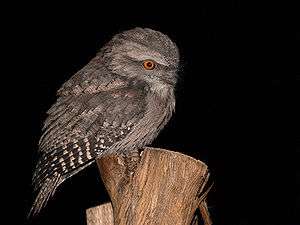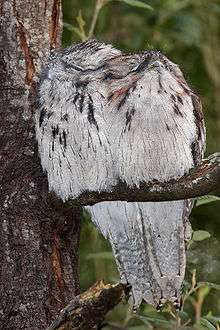Frogmouth
| Frogmouths | |
|---|---|
 | |
| Tawny frogmouth, at night | |
| Scientific classification | |
| Kingdom: | Animalia |
| Phylum: | Chordata |
| Class: | Aves |
| Order: | Caprimulgiformes |
| Family: | Podargidae Gray, 1847 |
| Genera | |
The frogmouths are a group of nocturnal birds related to the nightjars. They are found from the Indian Subcontinent across Southeast Asia to Australia.
Biology
They are named for their large flattened hooked bill and huge frog-like gape, which they use to capture insects. Their flight is weak. They rest horizontally on branches during the day, camouflaged by their cryptic plumage. Up to three white eggs are laid in the fork of a branch, and are incubated by the female at night and the male in the day. The three Podargus species are large frogmouths restricted to Australia and New Guinea, that have massive flat broad bills. They are known to take larger prey such as small vertebrates (frogs, mice, etc.), which are sometimes beaten against a stone before swallowing.[1] The ten Batrachostomus frogmouths are found in tropical Asia. They have smaller, more rounded bills and are predominantly insectivorous. Both Podargus and Batrachostomus have bristles around the base of the bill, and Batrachostomus has other, longer bristles which may exist to protect the eyes from insect prey.[1] In April 2007, a new species of frogmouth was described from the Solomon Islands and placed in a newly established genus, Rigidipenna.[2]
Taxonomy
DNA-DNA hybridisation studies have suggested that the two frogmouth groups may not be as closely related as previously thought, and that the Asian species may be separable as a new family, the Batrachostomidae.[3] Although frogmouths are traditionally included in the order Caprimulgiformes, another study has cast doubt on their placement within that order,[4] and they may be distinct enough to warrant an order of their own, Podargiformes, as Gregory Mathews proposed in 1918.
Species

- Genus Podargus
- Tawny frogmouth, Podargus strigoides
- Marbled frogmouth, Podargus ocellatus
- Papuan frogmouth, Podargus papuensis
- Genus Batrachostomus
- Large frogmouth, Batrachostomus auritus
- Dulit frogmouth, Batrachostomus harterti
- Philippine frogmouth, Batrachostomus septimus
- Gould's frogmouth, Batrachostomus stellatus
- Sri Lanka frogmouth, Batrachostomus moniliger
- Hodgson's frogmouth, Batrachostomus hodgsoni
- Short-tailed frogmouth, Batrachostomus poliolophus
- Javan frogmouth, Batrachostomus javensis
- Blyth's frogmouth, Batrachostomus affinis
- Sunda frogmouth, Batrachostomus cornutus
- Genus Rigidipenna
- Solomons frogmouth, Rigidipenna inexpectata
References
- 1 2 Perrins, Christopher (2003). Firefly Encyclopedia of Birds. Firefly Books. p. 342. ISBN 1-55297-777-3.
- ↑ Cleere; et al. (2007). "A new genus of frogmouth (Podargidae) from the Solomon Islands – results from a taxonomic review of Podargus ocellatus inexpectatus Hartert 1901". Ibis. 149: 271–286. doi:10.1111/j.1474-919x.2006.00626.x.
- ↑ Sibley, Charles G.; Alquist, John E.; Monroe, Jr., Burt L. (July 1988). "A Classification of the Living Birds of the World Based on Dna-Dna Hybridization Studies" (PDF). The Auk. 105 (3): 409–423. JSTOR 4087435.
- ↑ Mayr, G (2002). "Osteological evidence for paraphyly of the avian order Caprimulgiformes (nightjars and allies)" (PDF). Journal für Ornithologie. 143 (1): 82–97. ISSN 0021-8375.
External links
| Wikimedia Commons has media related to Podargidae. |
- Frogmouth videos on the Internet Bird Collection
- Video: Finding the Sri-Lanka Frogmouth, Southern India
- Scientists discover new genus of frogmouth bird in Solomon Islands